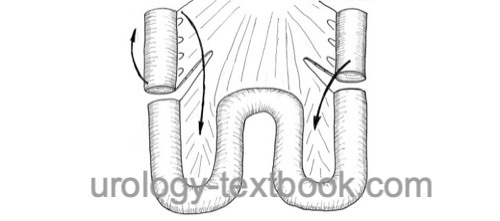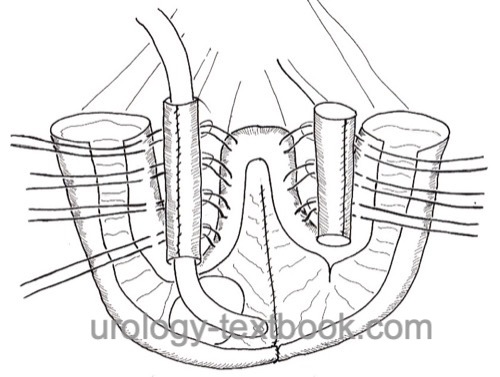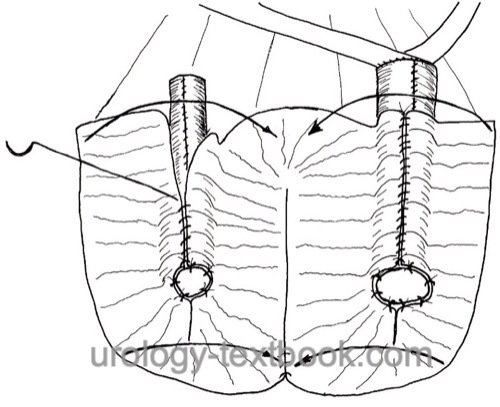You are here: Urology Textbook > Surgery (procedures) > Continent ileal pouch
Continent Ileal Pouch for Urinary Diversion: Surgical Technique (Step-by-Step) and Complications
The continent ileal pouch is a heterotopic continent urinary diversion after cystectomy, the reservoir is formed with ileum. Two serosal-lined ileal troughs are used as continence mechanism and antireflux mechanism (Anheuser et al., 2012). Different technical odifications and nomenclations exist: double T pouch (Stein et al., 2003a), serous lined extramural valves ileum pouch (Abol-Enein et al., 2004).
Indications for a Continent Ileal Pouch
Heterotopic continent urinary diversion should be offered to motivated and medically suitable patients for urinary diversion after cystectomy if the urethra or the urinary sphincter is not suitable for orthotopic urinary diversion.
Contraindications for Ileal Pouch
- Intestinal diseases (Crohn disease, ulcerative colitis, short bowel syndrome)
- After pelvic radiation therapy
- Chronic kidney disease (GFR <60–80 ml/min)
- Poor compliance
- Low life expectancy
- Lack of ability for self-catheterization
Step-by-Step: Surgical Technique of Ileal Pouch
Preoperative patient preparation:
Please see the section on radical cystectomy.
Bowel Dissection:
Isolate 48 cm ileum for the W-shaped pouch (4×12 cm), a 6–8 cm long oral ileum segment for a nonrefluxing ureteral anastomosis and an 8–10 cm aboral ileum segment for the continence mechanism. Perform ileoileostomy to restore bowel continuity. Carefully irrigate and clean the isolated bowel segments [fig. Ileal pouch 1].
 |
Longitudinal bowel incision:
Reposition the middle bowel segment forming a W and place stay sutures for orientation. Incise the bowel longitudinally at the antimesenteric border. Form the bowel plate of the pouch with running sutures connecting the limbs of the W (Vicryl 3-0).
Tapering of the oral and aboral ileal segments:
Taper the oral ileal segemt over a 30 CH catheter with a GIA stapler. The aboral ileal segment is tapered over an 18 CH catheter. The mesentericum of both segments are tunnelled at the avascular spaces (windows of Deaver).
 |
Serosal lined ileal tunnels:
Both tapered ileal segments are embedded [fig. Ileal pouch 2] in the serosal lined ileal trough and fixed with several sutures between the W-shaped limbs of the pouch. Pass the sutures through the opened windows of Deaver to preserve blood flow of the tapered ileal segments. The oral ileal segment for ureteral anastomosis is oriented isoperistaltically, and the aboral segment for the continence mechanism is oriented antiperistaltically. Close the pouch over both tapered ileal segments with a running suture [fig. Ileal pouch 3]. Insert an 18 CH catheter over the aboral ileal segment into the pouch.
 |
Ureteroilial anastomosis:
The ureters are widely spatulated and splinted with MJ ureteral stents (secured with 4-0 fast absorbing sutures), which allows for the atraumatic management of the ureters during the next steps. Dissect the ureters as little as possible to maintain their blood supply. Create a tunnel crossing the great vessels under the mesentery of the colon and bowel from the left to the right retroperitoneum with blunt finger dissection. Bring the left ureter to the right lower abdomen using the tunnel. A ureteroilial anastomosis is done comparable to an ileal conduit. Pass the MJ stents through the oral ileal segment into the pouch.
Closure of the pouch:
Fold the pouch plate in the longitudinal axis and close it with a running suture (Vicryl 3-0).
Umbilical stoma:
Remove the skin of the umbilicus and incise the fascia if necessary. Pass the catheter through the stoma. Create the anastomosis between the umbilical stoma and the aboral ileal segment with interrupted sutures 2-0 PDS. Fix the pouch with additional sutures to the ventral abdominal wall.
Postoperative Care after MAINZ Pouch
Please see the section urinary diversion for postoperative care.
Complications of MAINZ Pouch
In addition to the complications of cystectomy, see the section urinary diversion for complications of the continent urinary diversion.
| MAINZ pouch | Index | Prostate biopsy |
Index: 1–9 A B C D E F G H I J K L M N O P Q R S T U V W X Y Z
References
Abol-Enein, H.; Salem, M.; Mesbah, A.; Abdel-Latif, M.;
Kamal, M.; Shabaan, A. & Ghoneim, M.
Continent cutaneous ileal
pouch using the serous lined extramural valves. The Mansoura experience in
more than 100 patients.
J Urol 2004, 172, 588-591.
Anheuser, P.; Kranz, J.; Rausch, S.; Fechner, G.;
Müller, S. C.; Braun, M.; Steffens, J. & Kälble, T.
[Catheterizable
continence mechanisms for various urinary diversion reservoirs: serosa
lined and tapered ileum].
Urologe 2012, 51, 947-955.
Stein, J. P. & Skinner, D. G.
The craft of urologic surgery: the T pouch.
Urol Clin North Am 2003, 30, 647-61.
 Deutsche Version: Technik und Komplikationen des kontinenten Ileumpouches
Deutsche Version: Technik und Komplikationen des kontinenten Ileumpouches